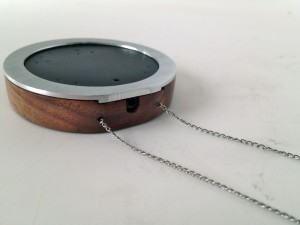WTI was out a lot last week, seeing a bunch of new wearable products here in New York City and listening to some interesting ideas. Not much trend or narrative emerged — the wearbles business isn’t quite mature enough to cohere that way — but some patterns may be starting to peek out.
Eyebeam, a gallery in the Chelsea section of New York, has an ongoing research initiative into “Computational Fashion.” Last Tuesday night, they held a panel on “Fashion and the Body,” chaired by Eyebeam’s Sabine Seymour. Panelists included the curator of the Fashion Institute of Technology’s museum Ariele Elian; designer Titania Inglis; research fellow Keren Oxman; and Jamal Motlagh, co-founder of the bespoke clothing store Acustom Apparel. Paul Amitai is the director of the Computational Fashion project.
Seymour and Amitai were featured speakers the next night at a Wearable Tech Demo evening at the HUGE agency’s home office in Brooklyn. Other speakers were the designer Despina Papadopoulous and the HUGE creative director Sherine Kazim.
And lastly, there was a reception for New York press that featured mostly well-established companies with real shipping products, most of which you’ve heard of. In the wearables arena, those products included Fitbit, Samsung, and Livescribe, which makes pen that records your handwriting and can turn it into type and stream it to and iPad app and Evernote.
Key observation of the week goes to FIT’s curator Ariele Elian, who noted that “the history of fashion is the history of technology”; that is, the two are inextricably linked. The cotton gin, the steam engine, the Jacquard loom, the sewing machine, artificial dying and printing — all are significant tech advances that led to industrial and societal changes far beyond their businesses.
In among the “wearable tech” like 3D printed nail tips, there were a couple of interesting projects that may have legs.
 Michelle Temple is building amulets with directional mics in them; people wear them around their necks, connect them to headphones, and can hear better. Temple is quite clear that these are not medical devices (which would put her square into the FDA-land), but they’re more than toys. Some, like the one pictured here, are quite lovely. All are the product of hand-soldering surface-mount components; she says she’s done 70, which by itself is quite an accomplishment.
Michelle Temple is building amulets with directional mics in them; people wear them around their necks, connect them to headphones, and can hear better. Temple is quite clear that these are not medical devices (which would put her square into the FDA-land), but they’re more than toys. Some, like the one pictured here, are quite lovely. All are the product of hand-soldering surface-mount components; she says she’s done 70, which by itself is quite an accomplishment.
Heatit is a small open-source hardware platform that outputs higher-than-generally-seen voltages and current. Each of the eight Heatit pins can output as much as 400mA. Heatit uses the Arduino IDE, so it’s also easy to program.
Tarana Gupta was showing a prototype wrist brace that monitors movement and vibrates when you stay in uncomfortable and potentially damaging positions for too long. It can help remediate and prevent RSIs; it could potentially help musicians perfect their technique.
The WTI takeaway: What’s new about wearable tech isn’t that technology and clothes are merging; they’ve always been merged. It’s not even new that the tech can change the nature of the clothes; new materials do that all the time. Think Gore-Tex.
What’s new is that tech can now change the very nature of what clothing is for, moving beyond the classic functions of decoration and protection. Other than activewear manufacturers like Nike and UnderArmour, it’s not clear that the clothing business is thinking about that. Keep it up, and they’re going to lose control of the equation. Tech companies need to understand more about clothes as a business and as a professional calling; the garment trade needs to learn about APIs, chip development cycles, and battery life.